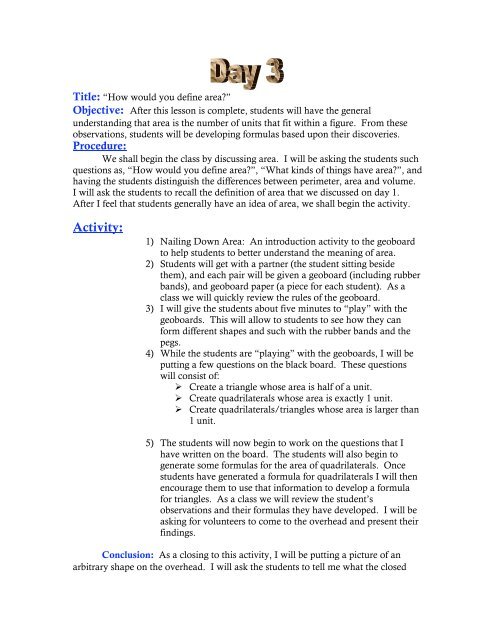%Unit: Perimeter & Area% %Grade level: 10- Geometry% %Time ...
%Unit: Perimeter & Area% %Grade level: 10- Geometry% %Time ...
%Unit: Perimeter & Area% %Grade level: 10- Geometry% %Time ...
Create successful ePaper yourself
Turn your PDF publications into a flip-book with our unique Google optimized e-Paper software.
Title: “How would you define area?”<br />
Objective: After this lesson is complete, students will have the general<br />
understanding that area is the number of units that fit within a figure. From these<br />
observations, students will be developing formulas based upon their discoveries.<br />
Procedure:<br />
We shall begin the class by discussing area. I will be asking the students such<br />
questions as, “How would you define area?”, “What kinds of things have area?”, and<br />
having the students distinguish the differences between perimeter, area and volume.<br />
I will ask the students to recall the definition of area that we discussed on day 1.<br />
After I feel that students generally have an idea of area, we shall begin the activity.<br />
Activity:<br />
1) Nailing Down Area: An introduction activity to the geoboard<br />
to help students to better understand the meaning of area.<br />
2) Students will get with a partner (the student sitting beside<br />
them), and each pair will be given a geoboard (including rubber<br />
bands), and geoboard paper (a piece for each student). As a<br />
class we will quickly review the rules of the geoboard.<br />
3) I will give the students about five minutes to “play” with the<br />
geoboards. This will allow to students to see how they can<br />
form different shapes and such with the rubber bands and the<br />
pegs.<br />
4) While the students are “playing” with the geoboards, I will be<br />
putting a few questions on the black board. These questions<br />
will consist of:<br />
‣ Create a triangle whose area is half of a unit.<br />
‣ Create quadrilaterals whose area is exactly 1 unit.<br />
‣ Create quadrilaterals/triangles whose area is larger than<br />
1 unit.<br />
5) The students will now begin to work on the questions that I<br />
have written on the board. The students will also begin to<br />
generate some formulas for the area of quadrilaterals. Once<br />
students have generated a formula for quadrilaterals I will then<br />
encourage them to use that information to develop a formula<br />
for triangles. As a class we will review the student’s<br />
observations and their formulas they have developed. I will be<br />
asking for volunteers to come to the overhead and present their<br />
findings.<br />
Conclusion: As a closing to this activity, I will be putting a picture of an<br />
arbitrary shape on the overhead. I will ask the students to tell me what the closed

















